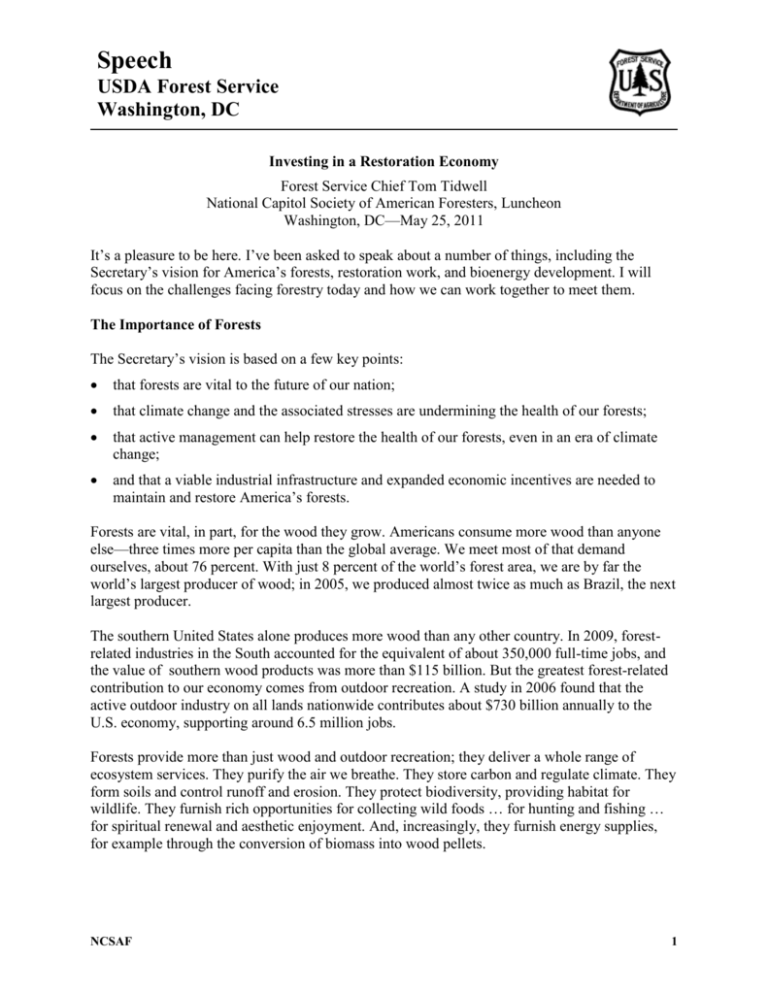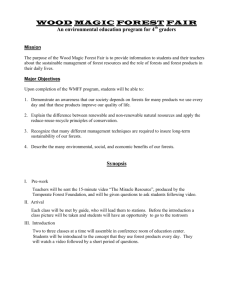u.s. forest service chief tom tidwell
advertisement

Speech USDA Forest Service Washington, DC Investing in a Restoration Economy Forest Service Chief Tom Tidwell National Capitol Society of American Foresters, Luncheon Washington, DC—May 25, 2011 It’s a pleasure to be here. I’ve been asked to speak about a number of things, including the Secretary’s vision for America’s forests, restoration work, and bioenergy development. I will focus on the challenges facing forestry today and how we can work together to meet them. The Importance of Forests The Secretary’s vision is based on a few key points: that forests are vital to the future of our nation; that climate change and the associated stresses are undermining the health of our forests; that active management can help restore the health of our forests, even in an era of climate change; and that a viable industrial infrastructure and expanded economic incentives are needed to maintain and restore America’s forests. Forests are vital, in part, for the wood they grow. Americans consume more wood than anyone else—three times more per capita than the global average. We meet most of that demand ourselves, about 76 percent. With just 8 percent of the world’s forest area, we are by far the world’s largest producer of wood; in 2005, we produced almost twice as much as Brazil, the next largest producer. The southern United States alone produces more wood than any other country. In 2009, forestrelated industries in the South accounted for the equivalent of about 350,000 full-time jobs, and the value of southern wood products was more than $115 billion. But the greatest forest-related contribution to our economy comes from outdoor recreation. A study in 2006 found that the active outdoor industry on all lands nationwide contributes about $730 billion annually to the U.S. economy, supporting around 6.5 million jobs. Forests provide more than just wood and outdoor recreation; they deliver a whole range of ecosystem services. They purify the air we breathe. They store carbon and regulate climate. They form soils and control runoff and erosion. They protect biodiversity, providing habitat for wildlife. They furnish rich opportunities for collecting wild foods … for hunting and fishing … for spiritual renewal and aesthetic enjoyment. And, increasingly, they furnish energy supplies, for example through the conversion of biomass into wood pellets. NCSAF 1 Speech USDA Forest Service Washington, DC But maybe the most compelling reason why forests are so important has to do with that most basic of human needs: water. Americans tend to take their drinking water for granted. Eighty percent of us live in urban areas, where we expect water to come out when we turn on the tap. But most of our drinking water comes from outside our cities—from our forests, farms, and ranches. In fact, our forests, our farms, and our ranches provide 87 percent of the surface supply of drinking water in the United States. I can’t think of a more compelling reason to manage these lands sustainably. Climate Change and Ecological Stresses Unfortunately, America’s forests are often in poor or declining health. The symptoms are clear: Many areas have been besieged by drought. According to the U.S. Drought Monitor, there is moderate to exceptional drought across the southern tier of states, from Arizona to Florida. As you know, drought-stressed forests are especially vulnerable to wildfire as well as to outbreaks of insects and disease. Entire landscapes are dead or dying across the West, at all elevations and latitudes … from pinyon pine, to lodgepole pine, to whitebark pine … from Arizona, to Colorado, to Idaho and Alaska. Drought-stressed forests … catastrophic fires … outbreaks of insects and disease … partly, these are symptoms of a changing climate. Changes in temperature and precipitation, in the timing and magnitude of weather events, are altering ecosystems and fire regimes. Milder winter temperatures are letting bark beetles reproduce faster and spread upslope and northward. Alaska alone has billions of trees killed by insects and other effects of a warming climate. Fragmentation is another concern. Our population is growing and our cities are expanding; for the first time since the 1920s, America’s net forest estate could shrink. Scientists have estimated a net forest loss of more than 30 million acres from 2002 to 2062. That’s an area the size of Pennsylvania. One study has predicted substantial increases in housing density from 2000 to 2030 on 57 million acres of forest land, an area larger than Utah. Urban growth could block the migration corridors that species will need in response to climate change. These stresses feed on one another. Drought, fire and fuels, invasive species, outbreaks of insects and disease, forest fragmentation and habitat loss, and the overarching challenge of climate change—these challenges have tremendous consequences through multiple feedback loops. It is no exaggeration to say we face challenges today as great as any in our nation’s history. Restoration and Infrastructure Needs The key is ecological restoration. By restoration, I do not necessarily mean restoring conditions within the historical range of variability. America’s forests have been changing for thousands of years; the salient feature of global climate change today is not landscape change itself, but rather the rate of change. Given the fragmented state of most American landscapes, high rates of environmental change can keep both plants and animals from successfully adapting. NCSAF 2 Speech USDA Forest Service Washington, DC Ecological restoration focuses less on ecosystem components than on ecosystem functions and ecological processes. Our goal is to restore the functions and processes characteristic of healthy ecosystems—ecosystems that can deliver all the services that Americans want and need, even if they are not exactly the same systems as before. Restoration includes helping ecosystems adapt to the effects of a changing climate, partly so that they can continue to mitigate climate change through carbon sequestration and storage. Climate change highlights the need for broad-scale approaches. Management action at a landscape scale can help ecosystems adapt to changes shaped by climate and other large-scale drivers. The Forest Service is therefore taking an all-lands, all-hands approach. If people continue to work in traditional ways—cut off from each other as private foresters on this piece of land, public servants on that piece of land—America will never fully tap its resources of knowledge, energy, and ideas to help meet the forestry challenges of the future. But if we can come together to collaborate across landownerships and landscapes, then we will be able to address shared issues and concerns and to pursue common goals more effectively. But for restoration to work at a meaningful scale, we need to invest as a nation in our green infrastructure. For decades, we have been losing infrastructure due to changing markets for wood. The FAO has been tracking global markets for wood since 1990, and it tells a story of long-term decline. From 1990 to 2005, wood removals in the United States fell by almost 10 percent. They also fell in Brazil, China, and Russia, three of the world’s other five major producers. The beneficiaries have been Canada and an array of smaller producers around the world, which have become more competitive. In response to stronger foreign competition, the U.S. forest products industry has had to retrench, becoming more capital-intensive, less labor-intensive, more productive, and more globally connected. These structural changes have profound social, economic, and environmental implications for sustainable forest management in the United States. Mills and plants have shut down, jobs have been lost, and stumpage prices have slumped. As a result, we lack capacity to effectively address large-scale forest health decline, such as the current bark beetle epidemic in the Rockies. The Forest Service is offering lodgepole pine from beetle-killed forests at prices as low as $7 to $10 per truckload, but we are not finding enough takers. The value of beetle-killed lodgepole pine is small, and it rapidly declines; even in the best of times, there might not be enough takers. But the economy is only slowly climbing out of recession. The housing market hasn’t recovered, and the financial crisis has made credit hard to obtain. The last mill in northern Colorado that can take large amounts of lodgepole pine is in receivership. The Forest Service has been forced to burn piles of small-diameter materials, and we are decking logs that might never be sold. NCSAF 3 Speech USDA Forest Service Washington, DC Opportunities Understandably, investors are reluctant to take risks without a guaranteed long-term supply of materials. In many areas, we are using coordinated resource offering protocols to help stabilize supply. These protocols help county, state, and federal land managers coordinate steady flows of wood to buyers. Another opportunity is stewardship contracting. This is not intended to replace timber sales, which we will continue to use. But where appropriate, stewardship contracts can achieve multiple outcomes on large landscapes over time. They create local jobs and economic opportunities by rebuilding infrastructure and getting money flowing through local economies. Multi-year contracts work best, because they stabilize the flow of work and materials over time, stimulating investments. We are exploring the feasibility of 15- to 20-year contracts, but our stewardship contracting authority will soon expire. We need permanent authority for stewardship contracting. SAF has taken the lead with Congress on this, and we thank you for your support. Biomass is another area of opportunity. We can get more bang for the taxpayer buck if we find new uses and markets for small-diameter materials, and we can also create new opportunities for the forest products industry. Our Forest Products Lab in Madison, Wisconsin, is focusing on finding new ways of utilizing woody biomass for generating heat and cogenerating heat and electricity. Up to $50 million in economic recovery funds administered by the Forest Service were earmarked for woody biomass utilization projects across the country. If Congress were to require more renewable energy use, demand for woody biomass could grow, increasing its value and creating more jobs in the woods. But the renewable energy standard, as defined by Congress, does not always facilitate the utilization of biomass from federal lands. SAF has taken the lead on this issue with Congress, and we deeply appreciate your efforts. Finally, we have an opportunity to take an integrated approach to natural resource management. The resources we manage, like forests, watersheds, and wildlife habitat, are naturally interconnected, and our goal is to achieve integrated long-term outcomes on a landscape scale. If that is our goal, then it only makes sense to manage these resources holistically across space and time. So it only makes sense to place separate budget line items for forest products, wildlife and fisheries, and so forth under a single line item for integrated resource restoration. Integrated resource restoration will allow the Forest Service to refocus our resources on enhancing forest and watershed resiliency, preventing the loss of large carbon sinks, and providing jobs. Consolidating budget line items will improve efficiency by reducing the number of accounting codes, capturing economies of scale, and simplifying federal contracting requirements. We need your support for integrated resource restoration. NCSAF 4 Speech USDA Forest Service Washington, DC Wildland Fire Management The last topic I want to touch on is wildland fire management. This is a critical forestry issue, especially in the West. A Forest Service study in 2002 found that almost 400 million acres in all ownerships were at moderate to high risk from uncharacteristically severe wildfires. That’s an area four times the size of California. Meanwhile, growth and development are exposing more homes and communities to wildland fire. Almost 70,000 communities are now at risk, and less than 10 percent have a community wildfire protection plan. These trends—fuel buildups, worsening fire danger, and a growing wildland/urban interface— spell trouble. We no longer regard all fire as bad, but “acres burned” is still a metric for approximating the extent of unwanted fires, and that metric has been growing. From 2000 to 2008, at least nine states had record-breaking fires. In 2000 and 2002, for the first time since the 1950s, more than 7 million acres burned in a single year. In 2004 and 2005, more than 8 million acres burned; in 2006 and 2007, it was more than 9 million. Some experts estimate that future fire seasons could reach 12 to 15 million acres. From 2000 to 2009, almost 28,000 homes, businesses, and outbuildings burned in wildfires. In response, through the FLAME Act of 2009, Congress required federal fire managers to develop a more cohesive wildland fire management strategy. In developing our new strategy, we brought together federal, state, tribal, local, municipal governments and nongovernmental organizations to develop a truly shared national approach—a national blueprint for addressing wildland fire management. Our National Cohesive Wildland Fire Management Strategy has three main goals. 1. The first goal is to create fire-adapted natural communities. The key is ecological restoration—restoring healthy, resilient ecosystems capable of withstanding stresses and disturbances, including those associated with climate change. 2. An equally important goal is to create fire-adapted human communities by treating fuels in the wildland/urban interface and by helping people adopt planning and building practices that make homes and communities safer from wildfire. 3. Our third goal is to make safe, effective, risk-based wildfire management decisions. Many of America’s landscapes evolved with fire; sooner or later, they will burn. Fire protection requires an appropriate response to wildfire—not only suppression, but also, where safe and beneficial, the use of fire for management purposes. We need to learn to live with fire. Investing in Green Infrastructure As you know, the Forest Service is more than a hundred years old. We have always managed the national forests and grasslands to sustain a range of multiple uses for future generations. But for our first 70 years, our main focus was often on commercial resource extraction—whether of forage, timber, or other resources. NCSAF 5 Speech USDA Forest Service Washington, DC In the last 20 to 30 years, our focus—and the focus of Americans in general, the people we serve—has broadened to include a full range of the goods and services, the benefits and values that people get from their forests and grasslands. People today understand that forests provide clean air and water, biodiversity, carbon sequestration, erosion control and soil renewal, opportunities for outdoor recreation, and more. Just as there is a greater public appreciation today for all the benefits Americans get from their forests, so there is a greater potential appreciation for everything we do as foresters and land managers to help sustain America’s forests for future generations. Our job is to deliver on that promise, and that will take investments in America’s green infrastructure. There are various ways we can make or stimulate those investments: through landscape-scale restoration treatments and through stewardship contracting, biomass utilization, and integrated resource restoration. To get there, we will need your help. SAF has already taken the lead in these areas, and we appreciate your support. We look forward to continuing our partnership far into the future. Thank you. NCSAF 6






